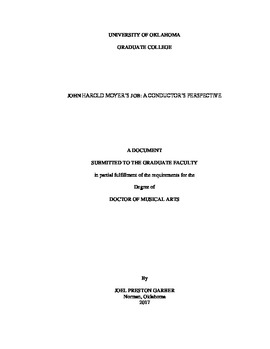| dc.contributor.advisor | Zielinski, Richard | |
| dc.contributor.author | Garber, Joel | |
| dc.date.accessioned | 2017-12-08T21:43:11Z | |
| dc.date.available | 2017-12-08T21:43:11Z | |
| dc.date.issued | 2017-12 | |
| dc.identifier.uri | https://hdl.handle.net/11244/52751 | |
| dc.description.abstract | The purpose of this study is to provide an analysis of John Harold Moyer’s
(1927-2012) cantata, Job, as well as a pedagogical method for the modern choral
director to prepare it for performance. The document is organized into five chapters:
Moyer’s life and times as well as his output and style; the composition of the cantata,
Job, and the origin of the libretto; an analysis of text, form, harmony, and orchestration;
pedagogical challenges and tools, and the conclusion. Moyer’s compositional style is a
unique synthesis. Correspondence with the composer’s wife, daughter, and
granddaughter during the research for this document contributes insight into the craft
and mind of Moyer’s compositional process. For the modern choral conductor to lead a
successful performance of Job, strict rehearsal planning and exercises carefully
designed from related motives from Job are required. The techniques and information
presented here will aid in the discovery of John Harold Moyer as a composer and serve
as a pedagogical tool for the performance and preparation of Moyer’s Job. | en_US |
| dc.language | en_US | en_US |
| dc.subject | Music | en_US |
| dc.subject | Conducting | en_US |
| dc.subject | Cantata | en_US |
| dc.subject | Moyer | en_US |
| dc.title | John Harold Moyer’s "Job": A Conductor’s Perspective | en_US |
| dc.contributor.committeeMember | Enrico, Eugene | |
| dc.contributor.committeeMember | Cortest, Luis | |
| dc.contributor.committeeMember | Howard, David | |
| dc.contributor.committeeMember | Riddick, Frank | |
| dc.date.manuscript | 2017-12 | |
| dc.thesis.degree | D.M.A. | en_US |
| ou.group | Weitzenhoffer Family College of Fine Arts::School of Music | en_US |
| shareok.orcid | 0000-0003-3176-8963 | en_US |
| shareok.nativefileaccess | restricted | en_US |
